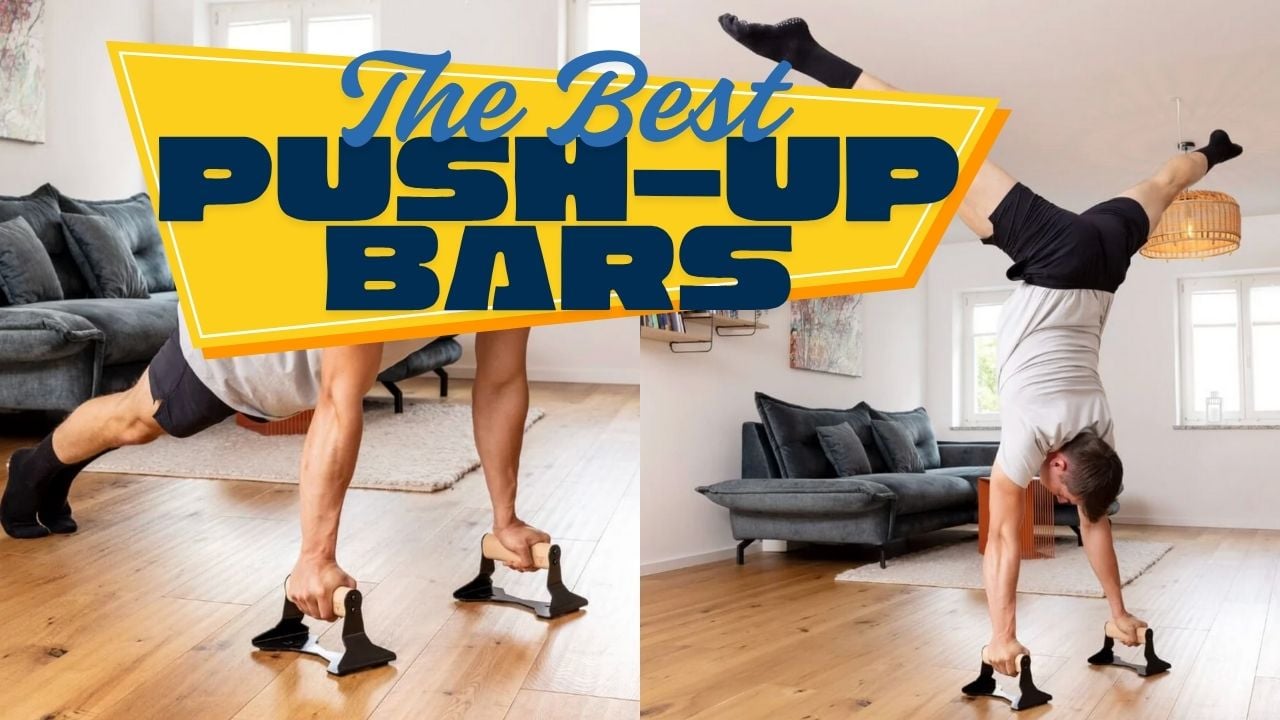Push-up bars belong to the ▶️ most essential calisthenics equipment.
If you’ve been doing push-ups for a while, you already know they’re one of the most effective bodyweight exercises to target the chest and triceps. But here’s the thing I’ve learned after coaching hundreds of people and training myself for over a decade: push-ups get dramatically better when you use a good pair of push-up bars.
I’m talking about better form, deeper range of motion, stronger chest engagement, more triceps recruitment, and — probably the biggest benefit for most people — far less wrist pain.
This guide is long and detailed because I want you to make a great buying decision and avoid the overpriced, flimsy, or straight-up dangerous options that are all over the internet.
Let’s get into it.
Why Push-Up Bars Are Worth It
1. They eliminate wrist pain
If you’ve ever felt that annoying ache or pressure on the front of your wrists when doing floor push-ups, you’re not alone. Most people simply lack the mobility to comfortably keep their wrists extended at 90 degrees.
A good push-up bar puts your wrist in a neutral, straight position, instantly removing most of that stress.
The first time I tried wooden push-up bars, I remember thinking:
“Why didn’t I start using these years ago?”
My reps felt cleaner, stronger, and more controlled — and my wrists finally stopped complaining.
2. You get a deeper range of motion
Push-up bars elevate your hands slightly off the floor. That tiny bit of height lets your chest dip lower, which:
- Engages more chest and shoulder muscle fibers
- Increases the stretch at the bottom
- Builds more strength in the end-range
- Improves lockout power
The difference feels small at first… until the next day, when you feel your chest in a way that floor push-ups rarely trigger.
3. More variety = better long-term progress
With bars, you can instantly change:
- Hand width
- Grip angle
- Bar rotation
- Incline/decline setups
- Parallette-style progressions
This keeps training interesting and solves one of the biggest problems with long-term push-up work: boredom.
4. Better shoulder positioning & scapular control
When the wrist is neutral, it becomes easier to align your shoulders and pack your scapula without compensating. Many beginners who struggle to “feel” their chest during push-ups suddenly feel the correct activation once they switch to bars.
5. Stability and safety
A quality bar:
- Doesn’t wobble
- Doesn’t slide
- Doesn’t rotate
- Feels rock-solid under your weight
This is essential, especially for heavier athletes, people doing deficit push-ups, or anyone doing explosive variations.
Cheap bars? They flex, bend, squeak, and sometimes even crack.
And trust me — a wrist injury is not worth saving $10.
Good bars usually cost $50–70, and they’ll last you years or even decades.
The 3 Push-Up Bars I Recommend
Below are the three bars I trust and recommend. I’ve used each of them for hundreds of workouts, and they all meet the “buy once, use forever” requirement.
1. Metal Push-Up Bars with Wooden Handles
My #1 Recommendation — The Best for Most Athletes
![Best Push-Up Bars [2025] 1 pullupdip wooden push up bars](https://calisthenics.com/wp-content/uploads/2024/10/pullupdip-wooden-push-up-bars.png)
- Ergonomic wooden handle
- Ultra stable design
- Outdoor-Friendly
- Non-slip pads
- Durable construction
![Best Push-Up Bars [2025] 2 gornation wooden parallettes small](https://calisthenics.com/wp-content/uploads/2024/10/gornation-wooden-parallettes-small.png)
- Low & Stable design
- Ideal for small spaces and travel
- Made with high-quality beech wood and steel
- Non-slip rubber feet for secure footing
- Free grip tape for enhanced grip and comfort
These are the bars I’ve been using for years, and honestly, they’re almost indestructible.
Why I love them
- Ultra-stable thanks to the metal base
- Wooden handle feels perfect in the hand
- No wrist pain at all
- Great for heavier athletes (super stable)
- Can handle deep deficit push-ups
- Perfect size for both beginners and advanced athletes
These have survived travel, sweaty workouts, outdoor training, and even some drops — and they still feel brand new.
My experience
The first week I used these, I felt the difference immediately:
- My wrists stayed neutral
- My chest activation increased
- I could vary my hand position without losing stability
- They inspired a ton of new variations in my push-up routine
If I had to recommend only one model, this is the one.
2. Wooden Mini Parallettes (Lightweight All-Wood Options)
![Best Push-Up Bars [2025] 3 best budget push up bars](https://calisthenics.com/wp-content/uploads/2025/05/best-budget-push-up-bars.jpg)
👉 Buy on GORNATION -> Best if you are shopping from the EU/UK/CH 🇪🇺 🇬🇧 🇨🇭
👉 Buy on Pullup & Dip -> Best if you are shopping from Germany 🇩🇪
These all-wood bars are lighter and easier to travel with. If you want something simple, minimalistic, and natural, you’ll love these.
Why I like them
- Super lightweight
- Full wood = warm, natural feel
- Don’t slip even with sweaty hands
- Surprisingly strong and stable
- Look great in any home gym setup
I’ve used these when traveling, filming workouts outdoors, or doing sessions where I don’t want heavier metal-base parallettes.
My experience
The grip is what stands out. Wood just feels right — even after long sets.
I also love how quiet and “soft” they feel when I place them on the floor. No metal clunking, no awkward weight.
Between the three EU versions, buy whichever is cheapest — they’re all good, I’ve tested all of them, and I trust them equally.
3. Affordable Wooden Push-Up Bars (Budget But Solid Option)
![Best Push-Up Bars [2025] 4 cheap push up bars](https://calisthenics.com/wp-content/uploads/2025/11/cheap-push-up-bars.jpg)
👉 Check Budget Push-Up Bars on Amazon
While I normally recommend premium bars, I know some people prefer a more budget-friendly wooden option that still avoids all the cheap flimsy plastic designs.
This category sits right between “cheap junk” and “premium”.
These bars are:
- Sturdy
- Wooden
- Comfortable
- Great for basic push-ups
- Safe and stable enough for everyday training
They won’t match the durability or heavy-duty feel of my top pick, but they’re absolutely good enough for beginners or someone wanting to test wooden bars without spending too much.
What to Look For in High-Quality Push-Up Bars
Over the years, after testing dozens of bars, I’ve developed a simple checklist. Before buying any pair, I ask:
✔ Is it made of wood or metal?
Wood handles feel the best, especially when sweaty. Metal bases add weight and stability.
✔ Does the base wobble?
A wide, stable base is one of the most important qualities. If it wobbles when you push sideways — don’t buy it.
✔ Anti-slip pads?
Rubberized feet are non-negotiable.
✔ Handle diameter
Ideally around 38–40 mm. Anything thinner feels cheap; anything thicker is a grip workout (not what you want during push-ups).
✔ Will it last years?
I want equipment I can trust for the long term. A well-built wooden bar can last a lifetime.
Avoid These Common Mistakes
❌ Buying $10 flimsy plastic push-up bars
These are unstable, unsafe, and genuinely risky for your wrists.
❌ Letting the bars wobble
Always press down, side-to-side, and check stability before starting.
❌ Forgetting to warm up your wrists
Do wrist circles, forearm stretches, and scapular push-ups.
❌ Only using one hand position
Rotate between wide, close, neutral, and decline setups.
❌ Treating bars like floor push-ups
You need to adjust your technique — use the neutral grip to its full advantage.
How to Use Push-Up Bars Correctly
Here’s how I teach my clients to get the maximum benefit.
Proper Setup
- Keep the bars parallel
- Shoulder-width apart for most people
- Grip with thumbs wrapped around
- Keep wrists straight (neutral)
- Engage your core and glutes before each rep
Essential Push-Up Variations to Try
Standard Push-Ups
Your baseline. Focus on clean lines and full ROM.
Deficit Push-Ups
Place your feet on a bench, hands on the bars.
This massively increases chest activation.
Close-Grip Triceps Push-Ups
Move the bars close together.
Perfect for building triceps power.
Wide Push-Ups
Move the bars wider.
Targets chest fibers that floor push-ups rarely hit effectively.
Incline Push-Ups
Put the bars on a low box.
This is great for beginners or high-rep work.
L-Sit Support Holds
Even with low bars, you can start developing L-sit strength.
Push-Up Bars vs Parallettes — Should You Buy Both?
If you want to expand your training beyond push-ups, then yes — parallettes are worth it.
They’re essentially bigger, taller push-up bars that allow:
- Handstands
- Handstand push-ups
- L-sits
- Dips (with creativity)
- Planche progressions
- Deeper push-up deficits
They’re heavier and bulkier, but in my opinion, they belong in every calisthenics-oriented home gym.
You can read ▶️ my full guide to parallettes here.
Final Recommendation
At the end of the day, great push-up bars are one of the simplest investments you can make to instantly improve your training. The right pair will reduce wrist strain, increase your range of motion, open up new variations, and make your push-ups feel smoother, stronger, and more controlled. After years of training and testing dozens of different models, the difference between cheap, flimsy bars and well-built wooden ones is night and day — not just in comfort, but in long-term safety and enjoyment.
Choosing the right type really comes down to your needs and training style: metal-base wooden bars offer the most stability, all-wood options feel great and are incredibly portable, and budget wooden models are perfectly fine if you simply want to upgrade from floor push-ups without overspending.
If you want the safest, most stable, and longest-lasting option — the kind you buy once and use for the next decade — I recommend the Wooden Push-Up Bars on Metal Base from Pullup & Dip. They’re rock solid, comfortable, and ideal for both beginners and heavier or more advanced athletes. You can check them ▶️ here on Amazon, or if you’re in the EU/UK, ▶️ the manufacturer’s website often has a better price (use our code CALIS10 for an extra discount).




